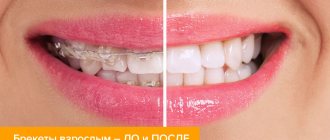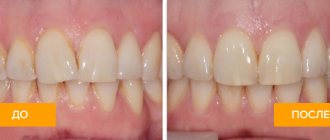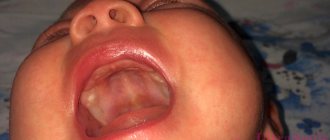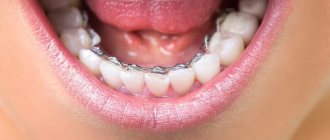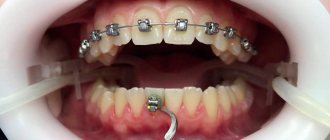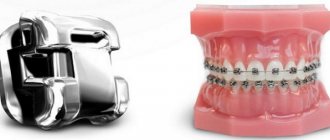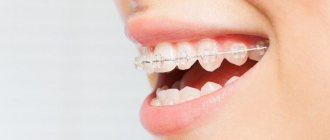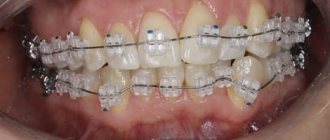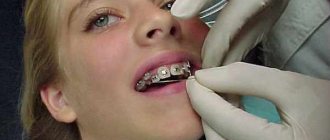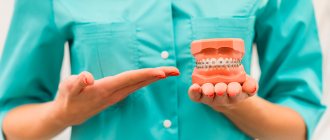Many people hesitate to get braces because they are unsightly. At the same time, they need to be worn for quite a long time - from several months to 2-3 years. Today, the problem of the aesthetics of orthodontic structures is easily solved: with the help of colorless or transparent braces. Let's find out what they look like and what they are.
In this article
- What do clear braces look like?
- Colorless braces: types and features
- Clear plastic braces
- Clear ceramic braces
- Transparent sapphire braces
- Alternative to clear braces
- Hygiene with braces
Wearing braces is the most effective method of treating malocclusion pathologies, which is suitable for almost all people, regardless of the condition of the teeth, age and other factors. Braces are a complex orthodontic structure consisting of many small parts: locks, screws, springs, arches, etc. If they are installed on the outside of the dentition, it is almost impossible to hide them. This is especially true for metal braces.
The aesthetic defect that structures create is one of the main reasons for a person’s refusal of orthodontic treatment. You have to wear braces for a long time: from 6 months to 2-3 years. It will not be possible to hide the presence of staples in the oral cavity from others during this entire time. However, you can still make them less noticeable. For this purpose, colorless or transparent braces are used. Let's tell you why they are called that.
What do clear braces look like?
Braces are made from various materials, including transparent and colorless. They are almost invisible when a person speaks or smiles. In other words, such braces are designed to hide the very fact of orthodontic treatment from other people. However, it is worth understanding that there are no such systems that are completely invisible if they are on the outside of the teeth.
Any orthodontic structure consists of dozens of elements. Locks, screws and other parts that are attached to tooth enamel can be made transparent or colorless. The arc of braces is always metal. She is the one who performs the main bite correction. It is not possible to refuse its installation. But it can be disguised. To make it less noticeable, it is painted white. In such cases, it becomes more aesthetic. However, it cannot be called absolutely invisible: upon closer examination, any interlocutor will notice it, even if he does not look closely.
It is possible to completely hide orthodontic treatment from others. For this purpose, lingual structures and aligners are used. But first, let's talk about transparent braces: their types, advantages and disadvantages.
Price for invisible braces
Ceramic braces have an aesthetic appearance, are quite reliable and effective, but although they are not very noticeable, they are still noticeable on the face. These are the most affordable of all types of invisible braces. Sapphire braces are completely transparent and practically invisible, giving your smile an attractive shine, but their presence can be revealed by a thin metal arch. The cost of such a system is slightly higher than a ceramic one and reaches 300,000 rubles.
Lingual braces are completely invisible to others, but they are more expensive than any other orthodontic structures.
The iOrtho clinic network provides high-quality services for correcting malocclusion with Invisalign aligners, sign up for a consultation now!
Colorless braces: types and features
There are several types of braces that appear clear or colorless:
- plastic;
- ceramic;
- sapphire.
The choice of orthodontic design is limited by medical indications and financial capabilities of the patient. There are cases when it is impossible for a person to get plastic braces, for example, in case of severe malocclusion. Then he can opt for ceramic or sapphire designs. If you don’t have enough money for them, you will have to wear metal braces. Let's describe each variety in more detail.
Indications and contraindications for bite correction using braces
Braces systems are non-removable orthodontic structures with which dentists correct various pathologies of the dentofacial apparatus.
Wearing braces is indicated in the following situations:
- malocclusion (congenital or acquired);
- crooked or crowded teeth;
- interdental spaces.
Braces therapy can be prescribed from the age of 12 to 13 years, when the full formation of the permanent dentition ends. Sometimes, for special medical reasons, treatment can begin at 9–10 years of age.
There are also contraindications. Braces cannot be installed:
- with a large number of missing elements of the dentition;
- for oncology;
- immune diseases;
- diseases of the blood and skeletal system;
- tuberculosis;
- for serious mental disorders;
- bruxism (teeth grinding).
The presence of indications and prohibitions for brace therapy is identified by an orthodontist at a consultation after examination, medical history and hardware diagnostics. Our clinic has all the necessary equipment to obtain reliable information about each specific clinical case.
Clear plastic braces
For the manufacture of plastic transparent braces, special high-quality plastic is used, which can be used in dentistry. Such designs are suitable for both teenagers and adults. Children are especially sensitive to the attention of their peers, so plastic braces are an ideal option for them. Firstly, they can be transparent, that is, almost invisible. Secondly, there are multi-colored models with locks in green, red, yellow, purple or blue. They look fun and stylish, and most importantly - much more attractive than metal products.
Let us list the main advantages of plastic brace systems:
- Aesthetics. The color of the plastic matches the enamel, and is therefore invisible to others.
- Large selection of multi-colored models. This is especially true for teenagers: if it is difficult to make braces invisible, you can make them beautiful and stylish.
- Convenience. A person wearing plastic braces feels more comfortable than wearing metal ones. In addition, the teeth and oral mucosa get used to them faster: plastic braces are lightweight and do not put as much pressure on the dentition as other types of orthodontic structures.
- Low cost. Plastic models are much cheaper than other types of braces.
Plastic structures also have disadvantages:
- They are not suitable for correcting severe malocclusions.
- They darken quickly if you do not follow hygiene rules and diet.
- More fragile and more likely to fail than metal ones.
- It takes longer to correct bite pathology.
Additionally, clear plastic braces are not lingual. They are installed only on the outside of the teeth. If such designs are contraindicated for the patient, and the aesthetic component is important for him, he will have to make a choice in favor of ceramic or sapphire braces.
Price
If we consider the price factor, then the price for invisible berects is ambiguous. When compiling it, a number of factors are included. If we talk about the most expensive and elegant products, then sapphire ones, which have a thin platform. Each platform is tailored to the individual tooth shape. Thanks to modern technologies that are actively used for the production of invisible braces, it is possible to obtain high precision, and the effectiveness of therapy can be predicted in the first stages. The cost of invisible braces in Russia is 80,000–15,000 rubles.
Installing braces is a necessary procedure, thanks to which it is possible to solve all problems associated with incorrect teeth and bite. The best option would be to install invisible structures that allow you to feel comfortable both while talking and eating.
Sources used:
- National Library of Medicine (USA)
- "Orthodontics. Textbook for dentists" (Kutsevlyak V.I.)
- Agadzhanyan, E.G. Notes of a good dentist / E.G. Aghajanyan. - M.: Omega, 2011.
Clear ceramic braces
Ceramic braces are marketed as transparent, but in reality they are more colorless. Sometimes they acquire a slight yellowish or beige tint. Such structures are made from polycrystalline ceramics and aluminum oxide. The doctor can choose a material that imitates the natural color of tooth enamel. The braces will adapt to its shade, becoming almost invisible. However, you can still see them, they are just not as catchy as metal or plastic multi-colored systems.
The main advantages of ceramic braces include the following points:
- There are many shades of ceramics, among which you can choose a model for a specific patient.
- They are resistant to dyes, therefore they do not limit a person’s consumption of coffee, tea and other drinks with dyes.
- They do not cause allergic reactions, as often happens when wearing metal structures.
- Bite pathologies are corrected faster compared to plastic models.
Disadvantages of ceramic systems include:
- They are more expensive than metal and plastic ones.
- They treat pathology longer than metal braces.
- Destroyed during dismantling.
Ceramic staples are also more fragile than metal ones. If a person plays sports and there is a risk of damage to the structure, it is better to install products made of metal or sapphire.
Transparent sapphire braces
Sapphire braces are made from sapphire, obtained artificially in the laboratory. It is much inferior to natural stone in terms of strength, but is superior to other orthodontic systems in this parameter. In addition, sapphire braces are almost invisible. They have the highest aesthetic properties.
List all the advantages of sapphire braces:
- Hypoallergenic. Sapphire is biocompatible with oral tissues, so the likelihood of developing allergies is minimal.
- Fast adaptation. Sapphire braces do not interfere with diction and do not rub the mucous membrane. Getting used to them occurs within a few days.
- High strength. Such structures are resistant to mechanical stress. You can play sports in them.
- The highest aesthetic standards. Sapphire braces are almost invisible. In addition, they do not change their external properties under the influence of food with dyes.
The only disadvantage of such systems is their high cost. Sapphire braces will cost 2-3 times more than metal or plastic structures.
Alternative to clear braces
Transparent braces made of plastic, ceramic and sapphire can be replaced with conventional metal structures that are installed on the inside of the teeth. Such orthodontic systems are called lingual. Unlike other braces, they are completely invisible.
However, such staples also have disadvantages:
- not suitable for all malocclusion pathologies;
- greatly complicate hygiene procedures.
In some cases, if there is a medical reason for this, the orthodontist may offer the patient aligners (aligners) - orthodontic devices made of plastic and silicone used to correct the bite. They are a plate that is put on the teeth for a certain time. This device corrects the bite by applying pressure to the jaws, just like braces, but the plates are changed periodically to increase the load on the dentition. During treatment, the patient can change several dozen aligners, it all depends on the severity of the pathology.
The aligners are completely transparent, so it is almost impossible to notice them on another person’s teeth. In addition, the aligners can be removed if necessary, for example, before important negotiations or a date.
There are other advantages of aligners: they can be removed before meals, they are easy to care for, there is almost no need to get used to them, etc. But mouth guards are prescribed only for minor bite defects, as well as at the last stage of orthodontic treatment, that is, after removing braces to consolidate the result of therapy.
Comparison of the main systems of lingual braces and Star Smile aligners
| Traditional lingual braces (Ormco STB, Inovation L, etc.) | Individual lingual braces Incognito | Individual lingual braces Win | Individual aligners Star Smile | |
| Invisibility and aesthetics | Completely invisible from the vestibular side | Completely invisible from the vestibular side | Completely invisible from the vestibular side | Can be seen upon very close examination |
| Discomfort | High because braces are on the inside of the teeth and interfere with the tongue. Long period of adaptation. | High because braces are on the inside of the teeth and interfere with the tongue. Long period of adaptation. | High because braces are on the inside of the teeth and interfere with the tongue. Long period of adaptation. | There is practically no discomfort. Very quickly addictive. |
| Effect on diction | Strong because braces interfere with the tongue | Strong because braces interfere with the tongue | Strong because braces interfere with the tongue | They have virtually no effect on diction since the aligners are very thin |
| Hygiene | Very complex requires the use of special brushes | Very complex requires the use of special brushes | Very complex requires the use of special brushes | Hygiene is normal, no changes |
| Efficiency in treating complex cases | It is possible to treat simple and moderately complex cases. Complex with restrictions. | It is possible to treat simple and moderately complex cases. Complex with restrictions. | It is possible to treat simple and moderately complex cases. Complex with restrictions. | It is possible to treat simple and moderately complex cases. Complex with restrictions. |
| Possibility to temporarily remove equipment | impossible | Impossible | Impossible | Possible during meals and hygiene |
| Effect on nutrition | You cannot eat solid foods, nuts, etc. | You cannot eat solid foods, nuts, etc. | You cannot eat solid foods, nuts, etc. | There are no food restrictions. |
| Hypoallergenic | Possible allergy in rare cases to nickel | Almost never happens since a gold-containing alloy is used | No data | Almost never happens since hypoallergenic plastic is used |
| 3D forecast of the final result of treatment | No | There is only a final position of the teeth | There is only a final position of the teeth | Yes, including the trajectory of the teeth and the position of the teeth on each aligner |
| Average treatment time | 24 months | 18 months | 18 months | 12 months |
| Equipment warranty | No | No | No | Eat. 5 years from the manufacturer |
| Average cost of treatment | 180-200 thousand rubles depending on the level of the clinic | 250-300 thousand rubles depending on the level of the clinic | 230-280 thousand rubles depending on the level of the clinic | 80 – 200 thousand rubles depending on the complexity of treatment and the level of the clinic |
| Expiration date | Standard braces but required approx. 2 weeks for the production of a mouth guard for indirect fixation | Individual braces, production and delivery time from Germany 4-6 weeks | Individual braces, production and delivery time from Germany 4-6 weeks | 4 working days virtual 3D forecast of the final result and |
| Appearance | ||||
| Dependence of treatment success on the doctor’s qualifications | Very high | High | High | Average |
Pay attention to the last point of the table. Dependence on the doctor’s qualifications very tightly “ties” the patient both to the choice of bite correction method and to the quality of treatment using braces.
In the case of treatment with aligners, the entire treatment process can be predicted and presented to the patient on a computer - a 3D virtual model. After this, all the doctor’s competence comes down to competent “service” for the patient, and many doctors do not like this approach - they want to completely subordinate the patient’s treatment to their will and decisions.
The treatment process thus includes subjective assessments of the orthodontist treating you and, as a result, the result of treatment with lingual braces completely depends on the competence of this doctor. In the case of treatment with aligners, the risk of getting a poor-quality result is practically reduced to zero.
Hygiene with braces
It is impossible to maintain the aesthetic appeal of braces throughout the entire treatment period without following the rules of hygiene. After installation of orthodontic appliances, you will have to brush your teeth more often and for longer than usual. In addition, you will need to buy additional hygiene products. Among them:
- Toothbrush with V-shaped bristles (CURAPROX Ortho).
- Mono-beam brush (CURAPROX 1006 Single & Sulcular).
- Brush (Hager & Werken Miradent Pic Brush Refills Pink).
- Rinses and balms (DRC ROCS “Active calcium”).
- Dental floss (Miradent Mirafloss implant chx).
- Irrigator with attachment for braces (Revyline RL100, Panasonic EW-1411).
You also need to remember your diet. To reduce the risk of damage to the structure and deterioration of its aesthetic properties, it is necessary to avoid solid foods, sweets, sticky foods and a number of other products.
Before purchasing brushes, dental floss, irrigators and other hygiene products, consult your doctor.
